Vickers Viscount Network
October 2011 Newsletter
Dear Member
Brooklands Viscount Day
Brooklands Viscount Day was a great success and was enjoyed by all who attended, and by the many hundreds of people around the
world who watched the live webcast. We, as a global group, have come a long way from our humble beginnings in just a few short
years.
A big vote of thanks goes to the many people who tirelessly worked to make the day possible. Julian Bourn has already
given a few ideas on how refinements can be made for the next event. Our meetings just keep on getting better and it will be
interesting to see where we go for the next Viscount Day. It need not necessarily be in the United Kingdom.
Presentations
The event was hosted by Julian Bourn and John Woodhouse who are both members of the Brooklands Museum and
Vickers Viscount Network 'Core' members.
Tom Singfield of FOVSP - 'Friends of Viscount Stephen Piercey' talked about the history of Viscount c/n 412 G-APIM.
John Woodhouse the Brooklands Museum's Viscount team leader, talked about the work and challenges that have
been completed so far, and the work and challenges that they face in the future to keep G-APIM in good order for
future generations to enjoy.
Romer Adams spoke about the Viscount Preservation Trust that was created in Liverpool in 1972 to save the oldest
surviving Viscount c/n 5 G-ALWF. During his presentation he announced that the Viscount Preservation Trust was to hand-over
ownership of 'WF' to the DAS - Duxford Aviation Society in November.
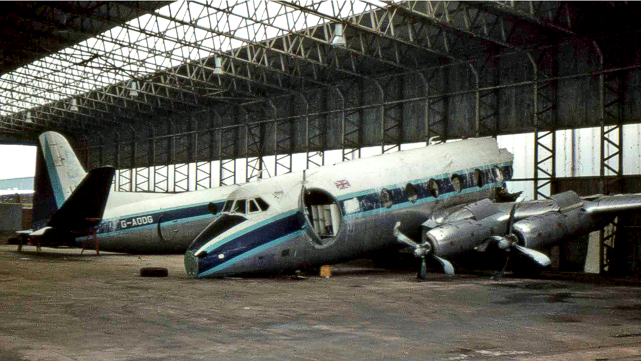
BMA - British Midland Airways Viscount c/n 77 G-AODG
 History and photos of Viscount c/n 77 G-AODG
History and photos of Viscount c/n 77 G-AODG
George Stringer talked about his long association with BMA - British Midland Airways Viscounts as an engineer.
The live webcast that was viewed by people all around the world was provided by Vickers Viscount Network co-founder and
webmaster Geoff Blampied and core member Simon Ellwood.
Unfortunately, Brian Burrage, Vickers Viscount Network co-founder, historian, photo archivist, and also a Dart
Engineer, was unable to attend due to illness. He was to talk about the Rolls-Royce Dart, the historic and ground
breaking engine which powered the Viscount. We wish Brian a speedy recovery.
From Weybridge to New Zealand via TCA (part two)
We continue Norm Hogwood's story, started in the previous newsletter, of his Viscount career.
"I always felt that NZNAC stole ZK-BRF! In the early part of 1959, NZNAC took delivery of its third Viscount, ZK-BRF
'City of Christchurch' and I found myself in a little difficulty the day after it left on its delivery flight.
Even though New Zealand was a good, keen, member of the Empire (as it was known in those days), it seems that there was
some doubt over NZNAC's ability to pay for spares and, as was the case with a number of airlines, Vickers-Armstrongs
needed to see the colour of money before the spares were released. The normal way this was done was by lodgement of a
'Letter of Credit' (L/C) with the bank against which Vickers-Armstrongs would draw for each shipment until the amount
covered by the L/C was exhausted.
While ZK-BRF was being fitted out for the delivery flight, I was busy organising the uplift of several large cases of
spares that NZNAC had ordered and which would normally have been shipped by sea freight. Most airlines took the opportunity
to use ferry flights for the carriage of such things and NZNAC was no exception. So it was that spares to the value of
about five thousand pounds were sent over to Wisley to be loaded on the aircraft.
I made daily inquiries about the L/C and kept being told it had not been sighted. I wasn't too worried as I was sure it
would arrive, but I was in for a bit of a shock one Monday morning when I discovered that ZK-BRF had left over the weekend!
My boss called me in and told me it had gone and asked me the value of the spares they had taken. He said he hoped for my
sake the L/C had turned up in time! I had to admit that it hadn't but pleaded that as nobody told me the aircraft was leaving
over the weekend it was hardly my fault.
Fortunately, it arrived a couple of days later and my bacon was saved. But it was interesting to see how a 'Motherland'
company treated one its most respected 'children' when it came to settling bills!" . . . to be continued.
Below is a photo taken on 23 March 1959 by the late Doug Walker of ZK-BRF on arrival at its home town of Christchurch,
complete with five thousand pounds worth of spare parts! Note the large gathering of staff watching the welcoming ceremony.
The three delivery air crew (see the shadows) are Captains Les Ransom, Colin Merrington and Jack Register.
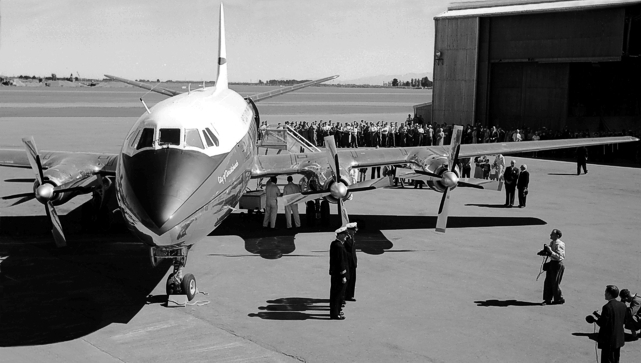
NAC - New Zealand National Airways Corporation Viscount c/n 283 ZK-BRF
 History and photos of Viscount c/n 283 ZK-BRF
History and photos of Viscount c/n 283 ZK-BRF
Norm Hogwood meets his old friend Terry Baker
Since sending these stories to us, Norm has been to Vancouver and reports, "My trip was an outstanding success and one of
the highlights was the visit to the BC Aviation Museum on Vancouver Island with the gang of retired airline ground safety
guys and their wives.
I also met up with Terry Baker (TCA/Air Canada 'The NetLetter' Editor), whom I worked with from 1959 to 1961 when I
was with TCA at Heathrow. (He and I have agreed to do it again in 50 years’ time!). We all had a great time at the museum as
you'll see from the attached pictures. To be up close and personal with that Viscount 757 c/n 224 CF-THG was a real thrill."
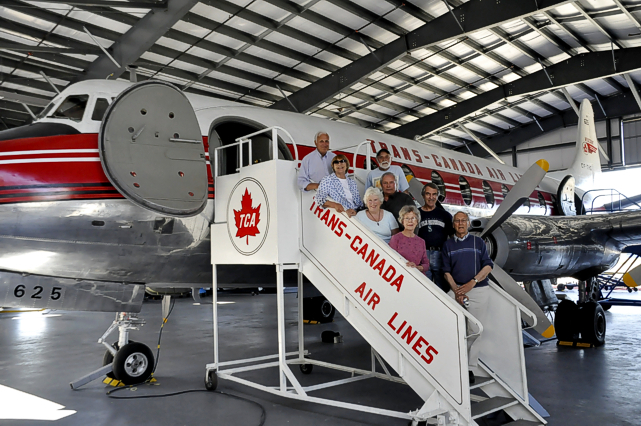
Norm Hogwood and the guys at the British Columbia Aviation Museum
>
 History and photos of Viscount c/n 224 CF-THG
History and photos of Viscount c/n 224 CF-THG
Australia Report
From Australia this report from Allan Taylor includes information from an article originally written for Flightpath
Magazine by Vickers Viscount Network Australian Researcher Peter Gates.
Much correspondence has flowed regarding slipper tanks on Viscount aircraft recently. In our previous Newsletter the focus
was on NZNAC - New Zealand National Airways Corporation having the fittings but in fact the Corporation's V.807s never had
the actual tanks fitted, even during the delivery flights, as indicated on ZK-BRF's above photo.
Retired NZNAC Viscount Captain Jim Pavitt comments, "They were never fitted to any of ours. They featured however
during the type rating technical course run in my case by Arch Beazor. In those days it was more of an engineering
course than operational! e.g. I could still draw the inner workings of the door locking and sealing mechanism! It also
lasted well over a month! There is no mention of them in my Viscount Pilot's notes book, but we were certainly aware our
first three aircraft, ZK-BRD - ZK-BRF had the capability of being fitted with them."
The slipper tanks were widely used in 'Oz' on the V.700 series TAA - Trans-Australia Airlines Viscounts. They were ideal
on the flight between Perth and eastern destinations such as Adelaide and Melbourne. I think by memory that the aircraft on
this route always encountered a 60+ mph headwind in one direction. For most aircraft, this necessitated an en-route refuelling
stop (and sometimes an overnight stop as well) in Western Australia.
The Viscount with the slipper tanks was the first airliner to be able to do both directions without an en-route fuel stop.
This gave them a big commercial advantage over the piston Douglas DC-4s and DC-6s that were also in use."
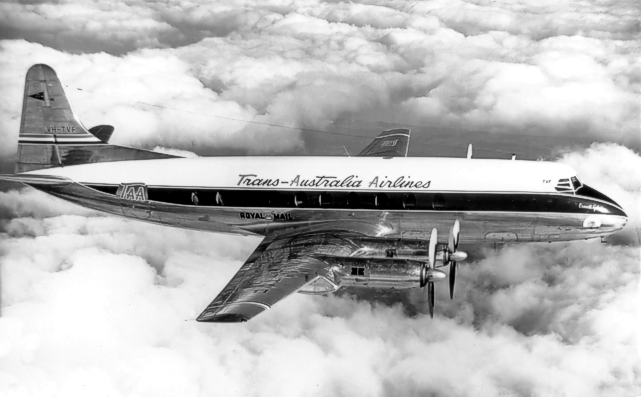
TAA - Trans-Australia Airlines Viscount c/n 49 VH-TVF fitted with slipper tanks
 History and photos of Viscount c/n 49 VH-TVF
History and photos of Viscount c/n 49 VH-TVF
As part of the 'Design Your Own' policy adopted by Vickers, VH-TVF c/n 49 was the first Australian Viscount delivered to
TAA with Slipper Tanks fitted. The two tanks, each one installed outboard of the outer engines, held 659 litres (145 gal)
which increased the fuel capacity to 10,165 litres (2,236 gal). This particular Viscount, fitted with the Dart 510s, had an
all-up weight of 28,123 kgs (62,000 lbs), an increase of 91 kg (200 lbs) over the original Type V.720s ordered by TAA.
Another update on the original Type V.720 Viscount was the use of Rotor paddle blades with 'squared off tips' rather than
the rounded and slightly pointed units previously used. The aircraft entered service on the Adelaide - Perth route against
the winds that had been the bane of Australian airlines for years. Although payload was restricted to 32 passengers,
regularity and performance was superb and steadily increased during the years.
So pleased was TAA with the performance of their Viscounts that an order for additional aircraft was placed in April 1955.
Designated the Type V.756, the first aircraft VH-TVH c/n 146 was delivered on 3 June 1956. The Mark 510 Darts were installed
along with slipper tanks, increasing the total fuel capacity to 10,183 litres (2,240 gals). As with the earlier Type V.720s,
the aircraft had seating for 44 passengers.
When first introduced TAA's Viscounts were responsible for other 'firsts'. They were the first fitted with the more powerful
Dart 506 engines, the first with increased internal fuel capacity, and the first to have external fuel tanks installed. This
extra fuel was necessary to cope with what was at the time the longest stage flown by any Viscount in regular service, the
1,380 miles (2,220 kms) between Adelaide and Perth, invariably against a stiff headwind.
When it was time to dispose of the TAA - Trans-Australia Airlines V.700 Series fleet, at least eight examples were scrapped
at various airports throughout Australia. Thankfully Viscount c/n 374 VH-TVN managed to evade the Australian scrap metal
merchants as it was sold to Botswana Airways in 1969. Two other Viscounts, c/n 47 VH-TVD and c/n 49 VH-TVF and were sold to
Keegan Aviation in the United Kingdom but ended their days on the scrap heap at Rochford, Southend, Essex, England.
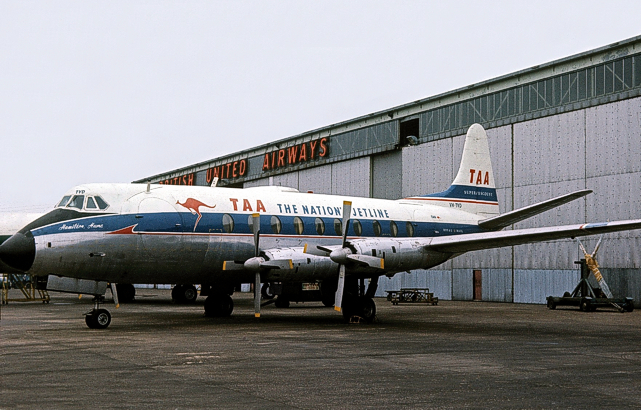
Viscount c/n 47 VH-TVD at Rochford, Southend, Essex, England in 1967
 History and photos of Viscount c/n 47 VH-TVD
History and photos of Viscount c/n 47 VH-TVD
Another interesting point was that Continental Airlines leased two Viscount V.812s to Capital Airlines. The two aircraft
c/n 356 N242V & c/n 354 N243V were used from December 1958 to March 1959 and were operated in full Continental livery with
Capital Airlines titles above the window line. On a lighter side, the interior décor of the Continental Viscounts so
impressed Australia's Sir Reginald Ansett that he reached an agreement to use the same colour consultant to design
the interior of his ANSETT-ANA aircraft.
Among the historical stories relating to the Viscount one must mention the late Howard Hughes. Well known for his
involvement with TWA - Trans World Airlines and the Lockheed Constellation, Hughes was one of many who haunted the Weybridge
production line facilities in the latter stages of 1953.
After ordering a single Viscount, c/n 82 designated a Type V.763, the aircraft suffered Hughes' scrutiny of virtually every
nut and bolt during construction. Due to his totally pedantic attention and the fact that the entire production line was
being held up, the aircraft was finally shunted aside. After some three years (at this stage Hughes was interested in the
Bristol Britannia and the Boeing 707) the Hughes project was sold to TACA - Transportes Aereos Centro Americanos in El
Salvador. Converted to a Type V.763D on the production line and registered YS-09C, the aircraft eventually crashed in
Nicaragua on 5 March 1959.
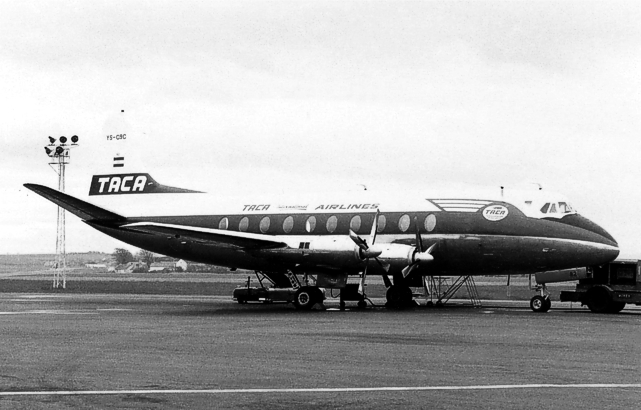
TACA - Transportes Aereos Centro Americanos Viscount c/n 82 YS-09C
 History and photos of Viscount c/n 82 YS-09C
History and photos of Viscount c/n 82 YS-09C
Editor's footnote
Peter Gates says if anyone would like to read his full original Flightpath Magazine article then they should
get in touch with him at
 Peter.Gates@VickersViscount.net
Peter.Gates@VickersViscount.net
When editing these stories I sometimes go behind the scenes to check for correctness. For example - when rechecking that
there is a hyphen in the TAA - Trans-Australia Airlines name, a Google search alerted me to the fact there is an active
TAA club with an extensive website.
 TAA - Trans-Australia Airlines Museum
TAA - Trans-Australia Airlines Museum
I think we should follow up on that one as there may be more untapped sources of information on TAA. Thinking further,
can anyone think of any other Viscount operator that just might happen to have a similar club or information resource? Over
to you to discover and tell us about them.
Visiting CF-TGI at The Pima Air and Space Museum, Tucson, Arizona
Readers of earlier newsletters may recall Vickers Viscount Network Canadian Researcher Jack Stephens' visit to Viscount
c/n 40 N22SN / CF-TGI at Tucson and his efforts to have this iconic aircraft better preserved. James Stemm, the museum's
curator, told Jack that the main problem was lack of interest in the aircraft and that he was the first person in his eleven
years there to ask any questions about it.
Now Vickers Viscount Network Canadian Researcher Ron Rhodes is planning a visit there in May 2012 and is keen to
once more, on our behalf, influence them to have the aircraft painted in a TCA - Trans-Canada Air Lines livery. Jack is
totally supportive of Ron's enthusiasm and wants the museum to understand that CF-TGI has not been forgotten and should be
given the treatment she thoroughly deserves. Readers will surely be interested to hear in due course how Ron gets on with
his visit.
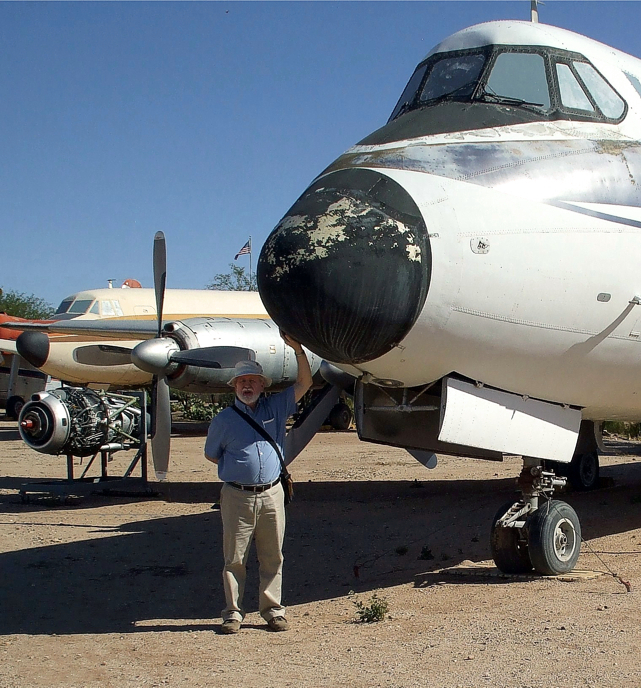
Jack Stephens with The Pima Air and Space Museum Viscount c/n 40 N22SN / CF-TGI
 History and photos of Viscount c/n 40 N22SN / CF-TGI
History and photos of Viscount c/n 40 N22SN / CF-TGI
Following Ron's e-mail, discussion has arisen regarding early TCA flights and centre on CF-TGI and CF-TGK. The discussion
is still going on at the time of closing this newsletter. Ron has supplied reference to various pages for readers to visit:-
 Flight Global news archive page 1
Flight Global news archive page 1
 Page 2
Page 2
 Page 3
Page 3
More on the 'Tay' Viscount
Vickers Viscount Network UK Researcher Craig Summerfield has kindly forwarded a picture of a model of the Tay
Viscount mentioned in a recent newsletter and has also expanded on the aircrafts history. He explains, "Have to hold my
hands up and admit that I had no part in building the model. It was actually a 'demo' model which I managed to acquire off
the 'nice' S and M guy at the LHR fair last year. It goes well with the 1/144 Corgi Viscounts in my collection and is
certainly a most unusual Viscount.
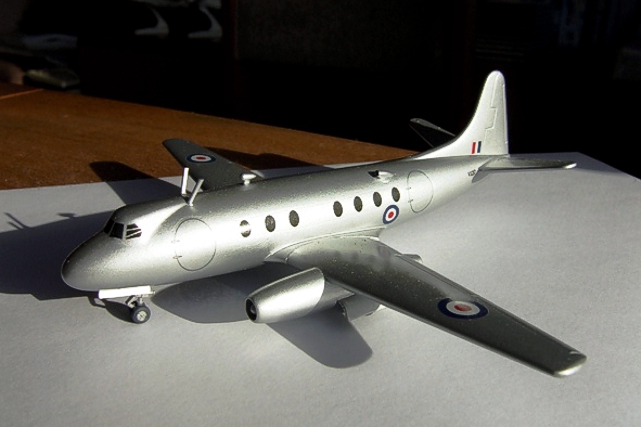
Craig Summerfield's model of the Tay Viscount
The 'Tay' Viscount
Initially registered G-AHRG to the Ministry of Supply (MoS) as a V.609 VC2 Viceroy on 23 May 1946, it was to be the second
prototype, and Armstrong Siddeley Mamba turbo-prop powered, designed to MoS specification 8/46. During assembly at Foxwarren,
it together with prototype G-AHRF were converted to V.630s with Rolls-Royce Darts and re-named Viscount due to change in
status in India.
Due to a slowdown in Viscount development after BEA - British European Airways Corporation's Airspeed Ambassador order and
the fact that the original design was too small, it was decided to modify this aircraft with Rolls-Royce Tay turbojets for
research purposes and it was re-designated Type V.663 to MoS specification E.4/49.
The civil registration G-AHRG was cancelled on 8 June 1949 as the aircraft was operating under military markings. No
C of A was issued although No 7797 was allocated. The military serial VX217 was applied and its civil registration G-AHRG was
never used.
First flight was on 15 March 1950 flown by Captain G.R. Bryce. Thanks to the Viscount's slippery shape, not much had to be
done to allow the higher speeds achieved by the switch to turbojet propulsion.
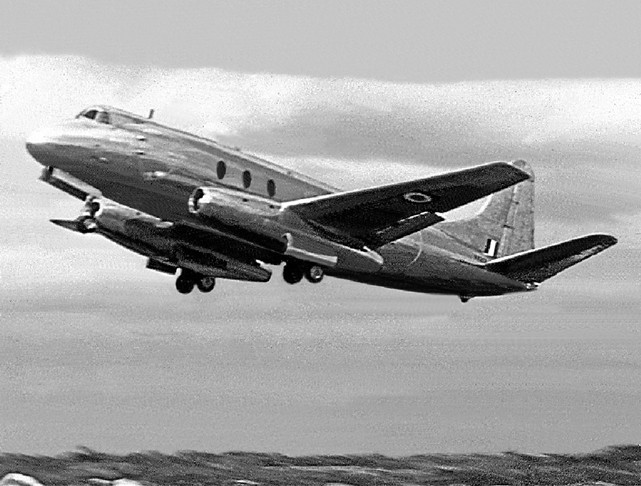
Ministry of Supply Viscount c/n 2 VX217 at the SBAC show at Farnborough, England
Its only public appearance was at the SBAC show at Farnborough, England between 3 and 11 September 1950, where it caused a
sensation by appearing to be faster than the de Havilland DH 106 with a short take-off and impressive rate of climb. Performance
figures were never published but the aircraft had a TOW of 18,144kgs and the Tay produced approximately 2,835kgs of thrust.
It was used on test flights to assist with the Vickers Valiant development, in particular the powered flight control systems
being developed by Bolton Paul. Based initially out of Seighford in Staffordshire, operating for the MoS, the aircraft was
leased on 7 October 1952 to Bolton Paul Aircraft and moved to Defford. This was after the MoD - Ministry of Defence awarded a
contract to design and install an electronic-signalling system, or fly-by-wire as it is now known.
Duplex DC signalled electrical channels were fitted to all three control surfaces, the first aircraft in the world so equipped.
This used a method of electronic impulses instead of control rods for transmitting the movements of the control column. The
first two test flights were flown by Bolton Paul test-pilot, Dickie Mancus during 1956. These were followed by Ben
Gunn with flights back at Seighford after the closure of Defford and the acquisition of Seighford by Bolton Paul for its
test flying, culminating with the first successful flight being flown with all three surfaces being controlled electrically.
This pioneering work lead to the technology used on Concorde and evolved into the current Airbus 'joystick' airliners.
The aircraft was subsequently leased for flight instrumentation test work to Louis Newmark Ltd and then to the Decca
Navigation Co Ltd. It was on a Decca test flight out of Seighford, when a hydraulic leak occurred in a wheel bay which
resulted in a fire. The crew managed to make a successful emergency landing back at Seighford but the fire had burnt through
the main spar and the aircraft was declared a write-off. Despite being intact, and a worthy candidate for preservation, the
aircraft was sold to International Alloys Ltd on 8 July 1959 and eventually scrapped.
 History and photos of Viscount c/n 2 VX217
History and photos of Viscount c/n 2 VX217
The 'Tay' Engine
In 1947, at the behest of the US Navy, Pratt & Whitney entered into an agreement to produce the Rolls-Royce Nene
centrifugal-flow turbojet engine under license as the J42 (JT6), for use in the early Grumman Panther fighter aircraft.
Concerned that the Nene would not have the potential to cope with future weight growth, Rolls-Royce were requested to design
a more powerful engine, which Pratt & Whitney would also produce. By 1948, Rolls-Royce had designed the Tay turbojet, also
a centrifugal-flow design and thirty per cent larger than the Nene.
However, Rolls-Royce had been developing an improved design with an axial compressor, which would become the Avon. As a
result, the development and final production of the Tay turbojet was left to Pratt & Whitney with the J48 (JT7) engine being
used on later Panthers, Cougars and Lockheed Starfires. Rolls-Royce retained the rights to the Tay outside of the United
States and 30 were supplied for the French Dassault Mystere IV with subsequent engines built under licence by Hispano-Suiza
as the Verdon. The only use of the engine in a British aircraft was on the Tay Viscount.
Viscount Flight Simulator
Simon Ellwood reports, "As requested by one of our new members, Alex Ford of Just Flight Ltd, I, and a couple
of other Vickers Viscount Network core members, are reviewing their latest Flight Simulator X add-on aircraft - a Viscount
V.814 of Lufthansa. I've just had my first 5 minute dabble with this and can say that so far I'm very impressed - much better
than other Viscount offerings in the flight simulator market. It has very good external detail, and... (yes!) pretty realistic
sounding Darts! Bliss. Only a couple of slight negatives so far".
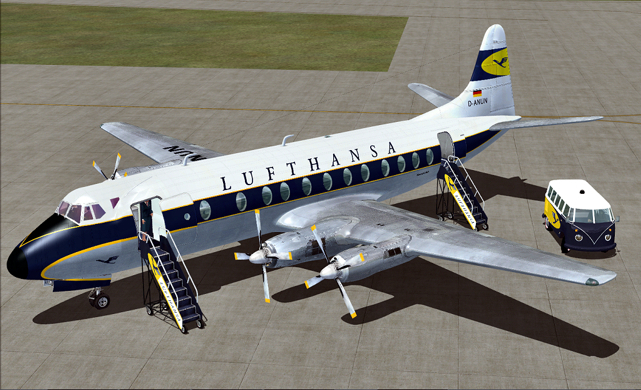
Lufthansa Simulator Viscount
Breaking News - Viscount Flight Simulator
Alex Ford has announced that his company had released the Viscount simulator on 28 October.
 Just Flight - Viscount
Just Flight - Viscount
The simulator is now available in twelve authentic international airline and military liveries:
• Aer Lingus - 1966
• Air Canada - 1974
• BEA - British European Airways - Red Square livery - 1960s
• BAF - British Air Ferries - 1981
• BMA - British Midland Airways - 1986
• Cambrian Airways – 1970s
• Continental Airlines - 1959
• Intra Airways - 1979
• KLM 'Royal Flying Dutchman' - 1959
• Lufthansa - 1968
• RAAF - Royal Australian Air Force - 1965
• TAA - Trans-Australia Airways – 1960
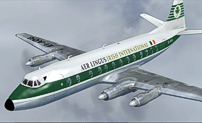
Aer Lingus
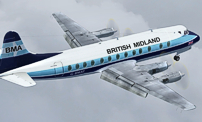
British Midland Airways
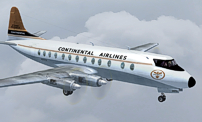
Continental Airlines
Some early Christmas presents I think . . . Ed.
TCA Emergency Landing
Update on TCA - Trans-Canada Air Lines' Viscount c/n 50 CF-TGM emergency landing at Dorval, Montreal, Quebec, Canada 9
April 1962.
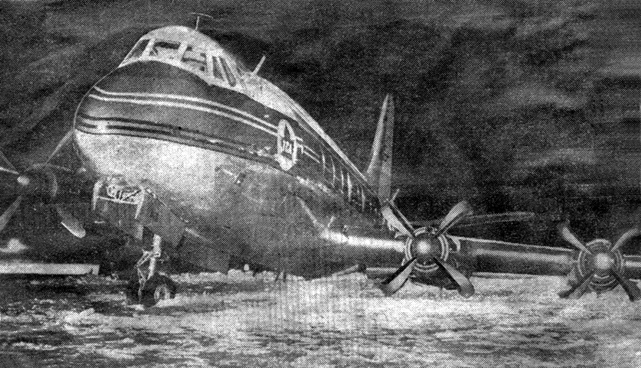
TCA - Trans-Canada Air Lines' Viscount c/n 50 CF-TGM
emergency landing at Dorval, Montreal, Quebec, Canada
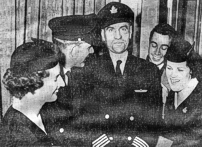
Flight Crew
Canadian Researcher Jack Stephens reports
"Besides Captain Chuck Kenworthy, we now know the First Officer
was Don A Stanger. Retired TCA - Trans-Canada Air Lines Captain Wally Hasker contacted another TCA/Air Canada
retired Captain, Keith Ohman, who gave the confirmation about incident and also happened to be on the flight. I
suspect we can assume that Don Stanger is the man to the right of Captain Kenworthy in the crew photo."
Vickers Viscount Network Canadian Researcher Dave Peters later added
"I had a chance to talk to Keith Ohman and he added an interesting detail. During an earlier trip with Chuck Kenworthy the
subject of gear up landings came up, the policy at the time was in the event of a main gear failure to extend, all gear should
be retracted and a belly landing made.
Chuck had said that if he was in that situation he would land with the single main and nose wheel locked down.
Following his accident it was noted that there was far less damage than a belly landing, in this case the aircraft was
back in service in four days. The book was changed to make the procedure standard operating practice."
Jack replies
"Thanks for the rest of the story on the emergency landing. It would be interesting to know the date when
TCA/Air Canada changed its policy, and if other airlines did the same? If any did, do we have incident reports?"
 History and photos of Viscount c/n 50 CF-TGM
History and photos of Viscount c/n 50 CF-TGM
Editor's note: The above correspondence shows the value in asking other people for information. They themselves
may not necessarily be a historian. If they do have a piece of key information, then it has been worth pursuing, and if
they see the value in having supplied it, they may come forward with more. It is also a good example where the
information supplied is backed up with confirmation from another source.
Also, appreciate that they do not necessarily need to be a pilot, cabin crew or an engineer - it should go without saying
that there are many other interesting people who have been involved with Viscounts who know things we would all love to
hear about.
Building a Viscount
Ian Miles of South Wales, who has recently joined us as a 'Core' member, says "I have been sitting on an itch to build a
Viscount for a long time, and having just cleared out my workshop things are looking a little bare. So I thought it was about
time I took the plunge and built myself a Viscount.
My main hobby over the last three decades has been model building in one form or another, plus from the age of twelve,
building and flying radio controlled models. This brings me to my reason for being here - I am researching the Viscount
and was directed towards your fabulous website. I hope to be able to contribute in some useful way and will be more than
happy to help out in any way I can - as indeed a number of your members have already helped me."
Following on from that e-mail Ian asks, "I am trying to compile a list of the main differences between the V.700 and V.800
series aircraft. I was wondering if anyone had put a list together, had a web page, or could help out with information. I am
concerned with fuselage and main measurement differences mostly, but anything would be a help. I know the size of the engines
and thus nacelles altered as the engines evolved with greater power outputs (would love to hear from anyone with nacelle
section details, measurements or diagrams?), but were there differences in the tails areas, wingspan, etc.?"
UK Researcher Ed Jones has subsequently supplied Ian with scans of the V.797 and V.802 Viscounts but anyone else who
thinks they can help Ian should contact him at
 Ian.Miles@VickersViscount.net
Ian.Miles@VickersViscount.net
Parcel Force
UK Researcher and ex BAF - British Air Ferries and BWA - British World Airlines Commercial Director Mike Sessions
informs us that registrations used on the Parcel Force contract all had a meaning.
G-OPAS stands for Go Parcel Service
G-OPFE stands for Go Parcel Force Europe
G-OPFI stands for Go Parcel Force International, and
G-PFBT stands for Parcel Force British Telecom.
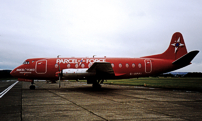
G-OPFI
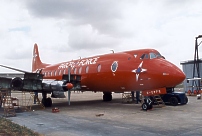
G-OPFE
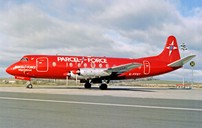
G-PFBT
New web pages
Since our last newsletter several new webpages have been added to the Museum. One of particular note is the story of
Cubana Viscount c/n 91 CU-T603 that was the subject of the first international airline hijacking originating on American soil.
 Compania Cubana de Aviacion Viscount hijacked
Compania Cubana de Aviacion Viscount hijacked
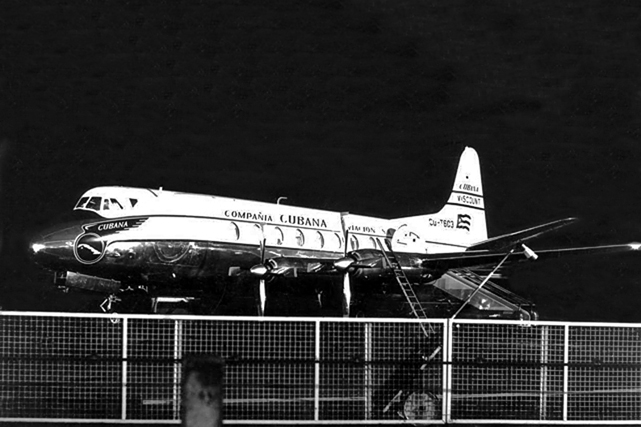
Cubana Viscount c/n 91 CU-T603 was hijacked on the 1 November 1958
>
 History and photos of Viscount c/n 91 CU-T603
History and photos of Viscount c/n 91 CU-T603
New Vickers Viscount Network 'Follow' Service
Colville Wemyss, an Internet Marketing Professional, who recently joined the Vickers Viscount Network as a core
member, has teamed up with our Co-founder and Webmaster Geoff Blampied to develop new ways to promote the museum to
a wider audience. Our first inchoative is a free follow service that notifies people who have signed up, of new photos, web
pages, and aircraft history updates added to our website, and details of forthcoming museum events.
To sign-up is easy, just click on the 'Follow' button below and you will receive short messages whenever we have an update,
sent directly to your Twitter account. If you do not have a Twitter account you will be invited to open one FREE of charge.
To ensure that you never miss any updates, you are able to adjust the settings of your Twitter account to have your messages
also sent to your mobile phone as a text message.
This facility will allow 'General' members, and others, to be updated in a similar way to how our 'Core' members are updated
at the moment. We emphasis that our 'Follow' service does not distribute messages from other organisations or people.
How to send us information and photos
To provide information and photos for inclusion in the Virtual Museum or our Newsletters, please send them to;-
 Membership@VickersViscount.net
Membership@VickersViscount.net
Photos should be scanned as a JPEG (.jpg) ideally producing an image of at least 600 KB to give us something to work from.
Scanning prints at 600 DPI and slides and negatives at 1,200 DPI usually produces good results.
Don't worry about the condition of your photos as we can work wonders with most images that have strange colours or dust
marks, blemishes etc.
Editorial and Production Team
Peter Layne - Chief Editor, Wellington, New Zealand.
Ed Jones - Editor, Manchester, England.
Dave Robinson - Production, Nottinghamshire, England.
Geoff Blampied - Website version production, Norwich, England
Although every endeavour is made to find an answer to questions, please appreciate that the team here at the Vickers Viscount
Network are all unpaid volunteers who fit this work in with their daytime jobs and chores around home. Any opinions expressed
in this publication are not necessarily those of the Vickers Viscount Network or the Newsletter Editors.



